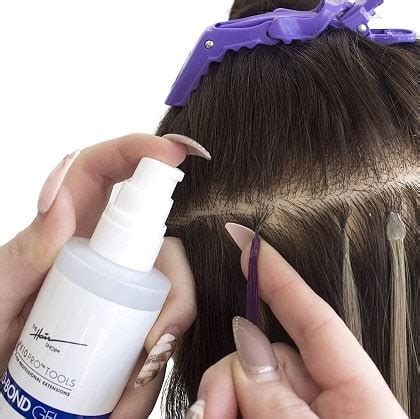Hair extensions have become increasingly popular in recent years, offering a versatile way to add length, volume, and color to your hair. However, choosing the right adhesive is crucial to ensuring a secure and comfortable hold. With numerous options available, navigating the world of hair extensions adhesives can be overwhelming.

Types of Hair Extensions Adhesive
1. Tape-in Adhesive:
- Invisible bond that mimics natural hair growth
- Quick and easy to apply
- Lasts up to 8 weeks
2. Glue-in Adhesive:
- Strongest hold, ideal for thicker hair or heavy extensions
- Requires professional application
- Can damage hair if not removed properly
3. Heat-Activated Adhesive:
- Requires a heated bonding tool
- Creates a flexible bond, allowing for movement
- Lasts up to 3 months
4. Clip-in Adhesive:
- Temporary solution, perfect for occasional use
- Clips onto your natural hair
- No damage or chemicals involved
5. Micro-Bead Adhesive:
- Tiny, keratin-based beads that clamp extensions onto hair
- Long-lasting, can last up to 6 months
- Requires professional installation and removal
How to Choose the Right Hair Extensions Adhesive
Consider the following factors when selecting an adhesive:
- Type of hair extensions: Different adhesives work better on specific hair types.
- Desired hold: Determine the level of hold you require based on the thickness of your hair and the weight of the extensions.
- Allergy concerns: Some adhesives contain chemicals that may cause allergic reactions. Test the adhesive on a small patch of skin before applying it to your hair.
- Longevity: Consider the desired lifespan of the extensions.
Step-by-Step Guide to Applying Hair Extensions Adhesive
1. Tape-in Extensions:
- Section off hair into thin rows.
- Apply double-sided tape to the base of the extension.
- Align the extension and press firmly against the natural hair.
- Use a flat iron to seal the bond.
2. Glue-in Extensions:
- Apply a thin layer of glue to the base of the extension.
- Press the extension into place on the natural hair.
- Hold firmly for 30 seconds to allow the glue to set.
3. Heat-Activated Extensions:
- Heat the bonding tool to the desired temperature.
- Place the extension onto the heated bonding tool.
- Press the extension into place on the natural hair.
- Allow the bond to cool and harden.
4. Clip-in Extensions:
- Open the clips on the extension.
- Position the extension at the base of your natural hair.
- Close the clips to secure the extension.
5. Micro-Bead Extensions:
- Thread a bead onto the extension strand.
- Clamp the bead onto the natural hair using pliers.
- Secure the bead with a heat tool.
Removing Hair Extensions Adhesive
1. Tape-in Extensions:
- Apply a bond remover to the tape.
- Use your fingers or a removal tool to gently separate the bond.
2. Glue-in Extensions:
- Apply a bond remover to the glue joint.
- Use a removal tool to gently loosen the glue.
- Break the bond and remove the extension.
3. Heat-Activated Extensions:
- Heat the bonding tool to the desired temperature.
- Place the tool near the bond to melt the adhesive.
- Gently remove the extension.
4. Clip-in Extensions:
- Open the clips on the extension.
- Remove the extension from your natural hair.
5. Micro-Bead Extensions:
- Use a bead remover to break the bead.
- Slide the bead off the extension strand.
- Remove the extension from your natural hair.
Pros and Cons of Hair Extensions Adhesive
| Adhesive Type | Pros | Cons |
|---|---|---|
| Tape-in | Invisible, quick to apply, easy to remove | Can slip or move, may require frequent re-taping |
| Glue-in | Strongest hold, long-lasting | Can damage hair upon removal, requires professional application |
| Heat-Activated | Flexible bond, long-lasting, versatile | Requires a heated tool, can melt if applied incorrectly |
| Clip-in | Temporary, no damage, easy to use | Can be bulky, may slip out of place |
| Micro-Bead | Long-lasting, secure hold, natural appearance | Requires professional installation and removal, can be uncomfortable |
Conclusion
Choosing the right hair extensions adhesive is essential for achieving a secure and comfortable bond. Consider the factors discussed above and select an adhesive that best suits your hair type and desired hold. By following the step-by-step instructions and taking proper care, you can enjoy beautiful and seamless hair extensions for months to come.
